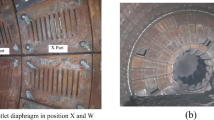Abstract
The performance of the micro nozzle is determined primarily by its machined surface topology. A circular cross-section micro-Laval nozzle is modeled and studied by using numerical simulation in this paper. The geometry of residual height and residual area of machined nozzle surface with flat-end milling cutter and ball-end milling cutter are created. It is found that the ball end milling cutter with large diameter is better than the flat one for nozzle finishing operations. The nozzle velocity performance is also revealed in this research. When residual height increased from 0.6 μm to 9.6 μm for nozzle with throat diameter less than 2 mm, the maximum outlet velocity of nozzle reduced gradually. The maximum outlet velocity of nozzle remains stable for the nozzle with throat diameter greater than 2 mm. The results show that the maximum outlet velocity of nozzle significantly reduces with throat diameter decreasing under constant residual height. Based on the analysis about velocity boundary layer, when residual height changing from 0.6 μm to 9.6 μm, the nozzle with throat diameter is 1 mm, has the boundary layer thickness ranging from 5% to 14% of outlet radius.
Similar content being viewed by others
Abbreviations
- M e :
-
the design Mach number for nozzle outlet
- r e :
-
outlet radius of nozzle
- r in :
-
inlet radius of nozzle
- L in :
-
convergent length of nozzle
- A e :
-
outlet area of nozzle
- A t :
-
throat area of nozzle
- γ :
-
the specific heat ratio
- h :
-
surface residual height
- s 1 :
-
surface residual area
- R :
-
the radius of cutter
- α :
-
the half angle of divergent section
- a p :
-
axial cutting depth
- d :
-
nozzle throat diameter
- y :
-
the coordinate values along the radial of the nozzle outlet
- h b :
-
boundary layer thickness
References
Hansen, W. W., Janson, S. W., and Helvajian, H., “Reduction in Ignition Energy for Single-Shot Microthrusters using Pulsedlaser Excitation,” Proc. of SPIE, pp. 743–751, 2002.
La Torre, F., Kenjereš, S., Moerel, J. L., and Kleijn, C., “Hybrid Simulations of Rarefied Supersonic Gas Flows in Micro-Nozzles,” Computers & Fluids, Vol. 49, No. 1, pp. 312–322, 2011.
Horisawa, H., Sawada, F., Onodera, K., and Funaki, I., “Numerical Simulation of Micro-Nozzle and Micro-Nozzle-Array Flowfield Characteristics,” Vacuum, Vol. 83, No. 1, pp. 52–56, 2008.
Torre, F. L., Kenjeres, S., Kleijn, C. R., and Moerel, J. L. P., “Effects of Wavy Surface Roughness on the Performance of Micronozzles,” Journal of Propulsion and Power, Vol. 26, No. 4, pp. 655–662, 2010.
Rossi, C., Rouhani, M. D., and Estève, D., “Prediction of the Performance of a Si-Micromachined Microthruster by Computing the Subsonic Gas Flow Inside the Thruster,” Sensors and Actuators A: Physical, Vol. 87, No. 1, pp. 96–104, 2000.
Chen, W., Fan, W., Zhang, Q., Peng, C., Yuan, C., and Yan, C., “Experimental Investigation of Nozzle Effects on Thrust and Inlet Pressure of an Air-Breathing Pulse Detonation Engine,” Chinese Journal of Aeronautics, Vol. 25, No. 3, pp. 381–387, 2012.
Lin, C. X. and Gadepalli, V. V. V., “A Computational Study of Gas Flow in a DeLaval Micronozzle at different Throat Diameters,” International Journal for Numerical Methods in Fluids, Vol. 59, No. 11, pp. 1203–1216, 2009.
Hao, P. F., Ding, Y. T., Yao, Z. H., He, F., and Zhu, K. Q., “Size Effect on Gas Flow in Micro Nozzles,” Journal of Micromechanics and Microengineering, Vol. 15, No. 11, pp. 2069–2073, 2005.
Köhler, J., Bejhed, J., Kratz, H., Bruhn, F., Lindberg, U., et al., “A Hybrid Cold Gas Microthruster System for Spacecraft,” Sensors and Actuators A: Physical, Vol. 97–98, pp. 587–598, 2002.
Bayt, R. L., Breuer, K. S., and Ayon, A. A., “DRIE-Fabricated Nozzles for Generating Supersonic Flows in Micropropulsion Systems,” Proc. of Sensors and Actuators Workshop, pp. 312–315, 1998.
Modica, F., Ferraris, E., Trotta, G., Fassi, I., and Reynaerts, D., “Fabrication of Micro-Nozzles Via μ-Edm Process,” Proc. of International Conference on Advances in Materials and Processing Technologies, pp. 1261–1266, 2011.
Louwerse, M. C., Jansen, H. V., Groenendijk, M. N. W., and Elwenspoek, M., “Nozzle Fabrication for Micropropulsion of a Microsatellite,” Journal of Micromechanics and Microengineering, Vol. 19, No. 4, Paper No. 045008, 2009.
Chu, W. S., Beak, C. I., Ahn, S. H., and Cho, T. H., “Rapid Prototyping and Testing of 3D Micro Rockets using Mechanical Micro Machining,” Journal of Mechanical Science and Technology, Vol. 20, No. 1, pp. 85–93, 2006.
Louisos, W. F., Alexeenko, A. A., Hitt, D. L., and Zilic, A., “Design Considerations for Supersonic Micronozzles,” International Journal of Manufacturing Research, Vol. 3, No. 1, pp. 80–113, 2008.
Shin, H. S., Park, M. S., Kim, B. H., and Chu, C. N., “Recent Researches in Micro Electrical Machining,” Int. J. Precis. Eng. Manuf., Vol. 12, No. 2, pp. 371–380, 2011.
Wang, S. M., Lin, J. J., Ye, Z. Z., Tsooj, S., and Wang, C. C., “A Micro Cutter Auto-Alignment System with on-Machine Positioning Error Measurement and Compensation Methods,” Int. J. Precis. Eng. Manuf., Vol. 15, No. 1, pp. 177–182, 2014.
Sutton, G. P., and Biblarz, O., “Rocket Propulsion Elements,” Wiley, pp. 50–51, 2001.
Author information
Authors and Affiliations
Corresponding author
Rights and permissions
About this article
Cite this article
Cai, Y., Liu, Z., Shi, Z. et al. Residual surface topology modeling and simulation analysis for micro-machined nozzle. Int. J. Precis. Eng. Manuf. 16, 157–162 (2015). https://doi.org/10.1007/s12541-015-0020-6
Received:
Revised:
Accepted:
Published:
Issue Date:
DOI: https://doi.org/10.1007/s12541-015-0020-6



